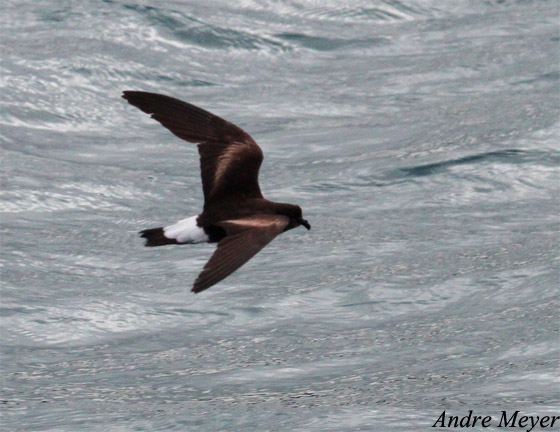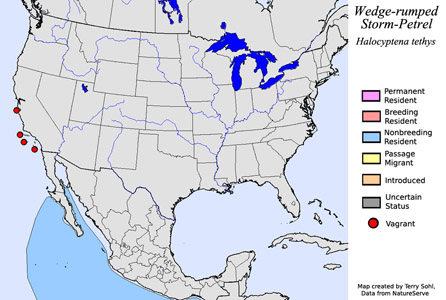| Length: 7 inches | Wingspan: 14.5 inches | Seasonality: Non-resident in South Dakota |
| ID Keys: Dark overall with obvious white, wedge-shaped rump | ||
 The
Wedge-rumped Storm-Petrel breeds off the west coast of South America, but
they can be found throughout much of the eastern Pacific outside of the
breeding season. In the United States, they are but rare vagrants,
having been found off the California Coast several times. There are
two breeding locations, one in the Galapagos, and one off the coast of Peru.
The two subspecies were formerly known as the Galapagos Storm-petrel and
Peruvian Storm-petrel, respectively, until research revealed they were one
species and they were renamed the Wedge-rumped Storm-petrel. The
Galapagos breeding population is the only storm petrel species that is
active at the breeding colony during daylight hours. It is thought
this unusual behavior may be due to the presence of nocturnal-hunting owls
on the islands.
The
Wedge-rumped Storm-Petrel breeds off the west coast of South America, but
they can be found throughout much of the eastern Pacific outside of the
breeding season. In the United States, they are but rare vagrants,
having been found off the California Coast several times. There are
two breeding locations, one in the Galapagos, and one off the coast of Peru.
The two subspecies were formerly known as the Galapagos Storm-petrel and
Peruvian Storm-petrel, respectively, until research revealed they were one
species and they were renamed the Wedge-rumped Storm-petrel. The
Galapagos breeding population is the only storm petrel species that is
active at the breeding colony during daylight hours. It is thought
this unusual behavior may be due to the presence of nocturnal-hunting owls
on the islands.
Habitat: Outside of the breeding season, they are true pelagics and are typically found quite a distance from the coast.
Diet: Mostly feeds on small fish, crustaceans, and squid.
Behavior: Forages by flying low over the water, looking for food. Like other storm-petrels, they will "patter" at the water's surface as they grab prey items. Most feeding is done at night.
Nesting: Breeds in colonies. The nest is placed in a rocky crevice or nook on a cliff. A single egg is laid, and both parents will help to incubate it. Incubation lasts about 7 weeks.
Migration: Breeds in the Galapagos and other islands off the coast of western South America. Outside of the breeding season they can be found well offshore in the eastern Pacific, from Mexico all the way southward to Chile.
Song: Does make a series of crisp, squeaky calls, primarily near their breeding sites.
Similar species: Similar in structure to several other storm petrels, but the large white rump plumage distinguishes them. The Wilson's Storm-Petrel is likely the closest in appearance, but the white on a rump of a Wilson's is less extensive, and a Wilson's has yellow feet if seen well.
Interactive eBird Map: Click here to access an interactive eBird map of Wedge-rumped Storm-petrel sightings
Conservation Status: Populations do appear to be declining, they are still numerous in much of their range and cover a wide geographic area. The IUCN lists the Wedge-rumped Storm-petrel as a species of "Least Concern".
Further Information: 1) Audubon Guide - Wedge-rumped Storm-petrel
2) BirdLife International - Wedge-rumped Storm-petrel
3) Cornell's Neotropical Birds - Wedge-rumped Storm-petrel
Photo Information: Photo taken by Andre Meyer - Photo licensed under Creative Commons Attribution NonCommercial ShareAlike 2.0 Generic License.
| Click below for a higher-resolution map |
 |
| South Dakota Status: Non-resident in South Dakota |
Additional Tristram's Storm-petrel Photos (coming soon!!)
